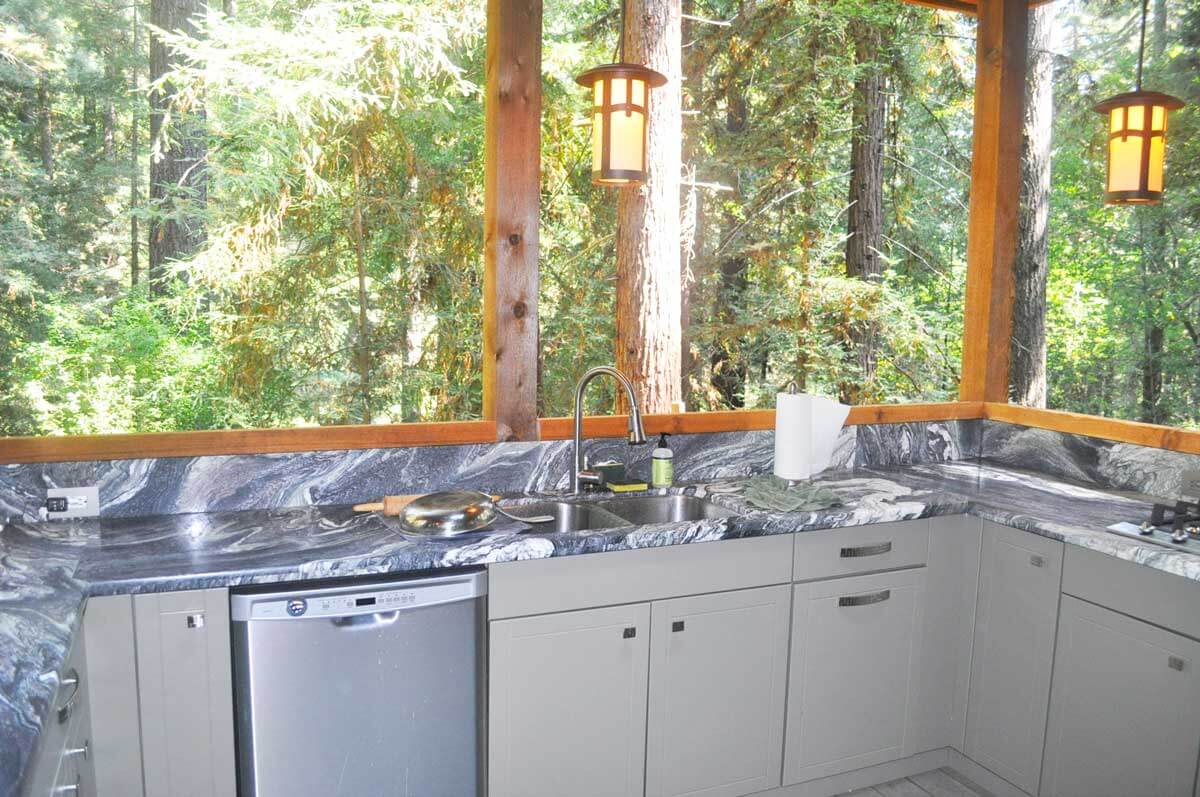Outdoor kitchens have become increasingly popular, giving homeowners a unique opportunity to extend their living spaces into the great outdoors. But a remarkable outdoor kitchen goes beyond just the appliances and functional elements; it seamlessly integrates with the surrounding landscape, creating a harmonious and inviting environment. In this article, we will explore the concept of outdoor kitchen landscaping and provide valuable tips and ideas on creating a seamless integration between your kitchen and the surrounding outdoor space.
Assessing the Existing Landscape:
Before diving into the design process, take the time to assess your existing landscape. Consider the natural features, such as trees, shrubs, or water elements, and determine how they can be incorporated into the overall design of your outdoor kitchen. Identify any potential challenges or limitations, such as uneven terrain or lack of privacy, and develop strategies to overcome them.
Defining the Functional Zones:
An outdoor kitchen typically has different functional zones, including cooking, dining, and relaxation areas. Start by defining these zones within your outdoor space. Consider the flow of traffic, the proximity to indoor spaces, and the desired level of privacy. By clearly delineating these zones, you can create a cohesive design that is both practical and visually appealing.
Natural Elements and Hardscaping:
To achieve seamless integration, blend the hardscaping elements of your outdoor kitchen with the natural surroundings. Use materials that complement the existing landscape, such as natural stone, brick, or wood. Incorporate organic shapes and textures that harmonize with the surrounding environment. For instance, use a stone veneer for the kitchen island or incorporate wooden pergolas or trellises for shade and visual interest.
Embrace Vertical Landscaping:
Vertical landscaping adds depth and visual appeal to your outdoor kitchen area. Incorporate vertical elements such as living walls, hanging plants, or trellises covered with climbing vines. These vertical accents soften the overall design and provide shade, privacy, and a sense of enclosure. Consider adding herb gardens or vertical planters near the cooking area to provide fresh ingredients while adding a touch of greenery.
Create Visual Transitions:
A seamless integration between your outdoor kitchen and the surrounding landscape can be achieved through visual transitions. Gradually blend the design elements from one area to another, creating a natural flow. Use pathways, stepping stones, or low walls to guide the eye and create a sense of connection between different zones. Incorporate strategic plantings or landscape lighting to highlight these transitions and enhance the overall aesthetic appeal.
Integrate Water Features:
Water features add a calming and tranquil ambiance to your outdoor kitchen area. Consider incorporating elements such as fountains, ponds, or waterfalls that provide a soothing soundscape and serve as focal points within your landscape. The gentle sound of water can create a relaxing atmosphere while complementing the natural beauty of your outdoor space.
Outdoor Lighting:
Proper outdoor lighting is essential for creating a seamless integration between your outdoor kitchen and the surrounding landscape. Incorporate a combination of ambient, task, and accent lighting to highlight architectural features, pathways, and plantings. Lighting extends the usability of your outdoor kitchen into the evening and adds an enchanting atmosphere to the overall space.
Seasonal Plantings and Color:
Introduce seasonal plantings and vibrant colors to your outdoor kitchen landscape. Select various plants that bloom at different times throughout the year, ensuring visual interest and beauty across all seasons. Consider using colorful flowers, ornamental grasses, or foliage with varying textures to add depth and visual appeal to your outdoor space.
Privacy and Screening:
Creating a sense of privacy is essential for a comfortable outdoor kitchen experience. Depending on your landscape and desired level of privacy, incorporate natural barriers, such as tall hedges, strategically placed trees, or ornamental grasses. These elements provide privacy and serve as a backdrop for your outdoor kitchen, enhancing its overall aesthetics and creating a secluded and intimate space.
Outdoor Seating and Gathering Areas:
Incorporate comfortable seating and gathering areas to further integrate your outdoor kitchen with the surrounding landscape. Consider using materials that blend seamlessly with the outdoor environment, such as weather-resistant wicker furniture or wooden benches. Arrange the seating strategically to encourage conversation and interaction while enjoying the beauty of the landscape.
Sustainable Landscaping Practices:
Incorporate sustainable landscaping practices into your outdoor kitchen design. Choose native plants that require less water and maintenance, reducing your environmental footprint. Implement water-saving techniques, such as drip irrigation or rainwater harvesting, to ensure efficient use of resources. By embracing sustainable practices, you create a seamless integration with the natural environment and contribute to the overall health of your outdoor space.
Outdoor Kitchen Garden:
Consider adding a kitchen garden near your outdoor cooking area. Grow herbs, vegetables, or even small fruit trees that can be used directly in your outdoor culinary creations. Not only does this provide convenience and freshness, but it also adds a touch of greenery and charm to your outdoor kitchen space.
Incorporating Shade Structures:
Shade structures play a vital role in creating a comfortable outdoor kitchen environment. Install pergolas, umbrellas, or retractable awnings to provide relief from the sun’s heat and create shaded areas for dining and relaxation. Choose materials and designs that blend harmoniously with the overall landscape and complement the architectural style of your home.
Outdoor Entertainment Areas:
Extend the integration of your outdoor kitchen by incorporating entertainment areas. Consider adding a fireplace or fire pit for cozy gatherings during cooler evenings. Install an outdoor sound system to provide music or audio entertainment. Create a dedicated space for outdoor games, such as a bocce court or a horseshoe pit, to encourage outdoor fun and interaction.
Professional Landscape Design Assistance:
If you feel overwhelmed or lack expertise in landscape design, consider seeking professional assistance. Landscape designers or architects specializing in outdoor kitchen landscaping can provide valuable insights and creative ideas and ensure your vision is translated into a cohesive and visually stunning outdoor space.
Conclusion:
Outdoor kitchen landscaping is about seamlessly integrating your outdoor cooking space and the surrounding landscape. You can achieve a harmonious and inviting outdoor kitchen by considering the existing natural elements, blending hardscaping with organic materials, embracing vertical landscaping, creating visual transitions, and incorporating water features, lighting, and privacy. Remember to incorporate sustainable practices, comfortable seating areas, and additional entertainment features to enhance your outdoor living experience. With careful planning and attention to detail, your outdoor kitchen will seamlessly blend with its surroundings, allowing you to fully enjoy the beauty of nature while indulging in culinary delights.

